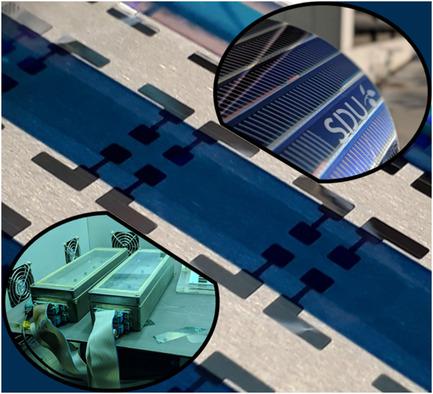当前位置:
X-MOL 学术
›
Energy Technol.
›
论文详情
Our official English website, www.x-mol.net, welcomes your feedback! (Note: you will need to create a separate account there.)
Degradation Behavior of Scalable Nonfullerene Organic Solar Cells Assessed by Outdoor and Indoor ISOS Stability Protocols
Energy Technology ( IF 3.8 ) Pub Date : 2020-06-10 , DOI: 10.1002/ente.202000295 William Greenbank 1, 2 , Naas Djeddaoui 1, 3 , Elodie Destouesse 1 , Jani Lamminaho 1 , Michela Prete 1 , Larbi Boukezzi 3 , Thomas Ebel 2 , Lakhdar Bessissa 3 , Horst-Günter Rubahn 1 , Vida Turkovic 1 , Morten Madsen 1
Energy Technology ( IF 3.8 ) Pub Date : 2020-06-10 , DOI: 10.1002/ente.202000295 William Greenbank 1, 2 , Naas Djeddaoui 1, 3 , Elodie Destouesse 1 , Jani Lamminaho 1 , Michela Prete 1 , Larbi Boukezzi 3 , Thomas Ebel 2 , Lakhdar Bessissa 3 , Horst-Günter Rubahn 1 , Vida Turkovic 1 , Morten Madsen 1
Affiliation

|
The development of nonfullerene acceptors (NFAs) has led to dramatic improvements in the device efficiencies of organic photovoltaic (OPV) cells. To date it is, however, still unclear how those laboratory‐scale efficiencies transfer to commercial modules, and how stable these devices will be when processed via industrially compatible methods. Herein, the degradation behavior of lab‐scale and scalable OPV devices using similar nonfullerene‐based active layers is assessed. It is demonstrated that the scalable NFA OPV exhibits completely reversible degradation when assessed in ISOS‐O‐1 outdoor conditions, which is in contrast to the laboratory‐scale devices assessed via the indoor ISOS‐L‐2 protocol. Results from transient photovoltage (TPV) indicate the presence of charge trap formation, and a number of potential mechanisms are proposed for the selective occurrence of this in laboratory‐scale devices tested in ISOS‐L laboratory conditions—ultimately concluding that it has its origins in the different device architectures used. The study points at the risk of assessing active layer stability from laboratory‐scale devices and degradation studies alone and highlights the importance of using a diverse range of testing conditions and ISOS protocols for such assessment.
中文翻译:

通过室内和室外ISOS稳定性协议评估可扩展非富勒烯有机太阳能电池的降解行为
非富勒烯受体(NFA)的发展已导致有机光伏(OPV)电池器件效率的显着提高。但是,到目前为止,仍不清楚如何将这些实验室规模的效率转移到商业模块上,以及通过工业兼容方法进行处理时这些设备将如何稳定。在此,评估了使用类似的基于非富勒烯的有源层的实验室规模和可扩展的OPV设备的退化行为。结果表明,在ISOS‐O-1室外条件下进行评估时,可扩展的NFA OPV表现出完全可逆的退化,这与通过室内ISOS‐L-2协议评估的实验室规模设备形成了鲜明对比。瞬态光电压(TPV)的结果表明存在电荷陷阱,并提出了一些可能的机制来选择性地在ISOS-L实验室条件下测试的实验室规模的设备中发生这种情况,最终得出结论,它起源于所使用的不同设备架构。这项研究指出了仅通过实验室规模的设备和降解研究评估活性层稳定性的风险,并强调了使用多种测试条件和ISOS协议进行此类评估的重要性。
更新日期:2020-06-10
中文翻译:

通过室内和室外ISOS稳定性协议评估可扩展非富勒烯有机太阳能电池的降解行为
非富勒烯受体(NFA)的发展已导致有机光伏(OPV)电池器件效率的显着提高。但是,到目前为止,仍不清楚如何将这些实验室规模的效率转移到商业模块上,以及通过工业兼容方法进行处理时这些设备将如何稳定。在此,评估了使用类似的基于非富勒烯的有源层的实验室规模和可扩展的OPV设备的退化行为。结果表明,在ISOS‐O-1室外条件下进行评估时,可扩展的NFA OPV表现出完全可逆的退化,这与通过室内ISOS‐L-2协议评估的实验室规模设备形成了鲜明对比。瞬态光电压(TPV)的结果表明存在电荷陷阱,并提出了一些可能的机制来选择性地在ISOS-L实验室条件下测试的实验室规模的设备中发生这种情况,最终得出结论,它起源于所使用的不同设备架构。这项研究指出了仅通过实验室规模的设备和降解研究评估活性层稳定性的风险,并强调了使用多种测试条件和ISOS协议进行此类评估的重要性。


























 京公网安备 11010802027423号
京公网安备 11010802027423号